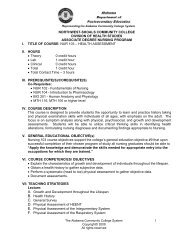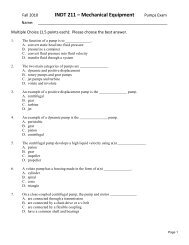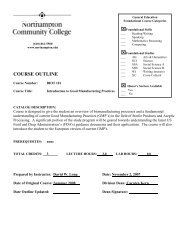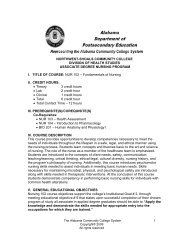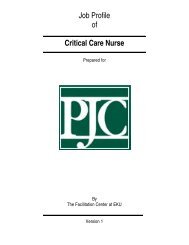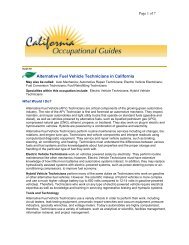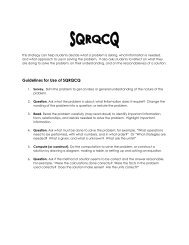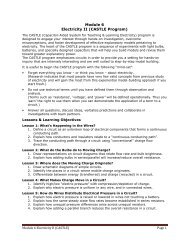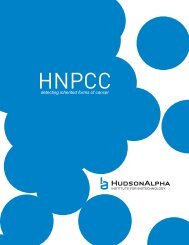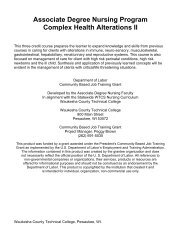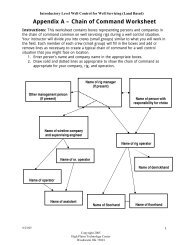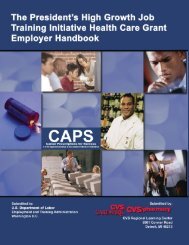i. Module 4 Fluids and Thermodynamics ... - Workforce 3 One
i. Module 4 Fluids and Thermodynamics ... - Workforce 3 One
i. Module 4 Fluids and Thermodynamics ... - Workforce 3 One
Create successful ePaper yourself
Turn your PDF publications into a flip-book with our unique Google optimized e-Paper software.
11. Calculate the pressure by considering the weight of the books, <strong>and</strong> the area of the pistonsupporting them. Make the necessary measurements, <strong>and</strong> calculate the pressure inNewtons / square meter.12. Calculate the pressure by considering the weight of the books, <strong>and</strong> the area of the pistonsupporting them. Make the necessary measurements, <strong>and</strong> calculate the pressure inNewtons / square meter.13. Compare the pressure just calculated to the slope of the graph <strong>and</strong> comment.Boyles Law (Optional)Unlike liquids, which have a relatively constant volume, a sample of gas may vary greatly involume. The volume <strong>and</strong> pressure are related by a mathematical formula called Boyle's Law.This lab provides data that may be analyzed to discover this formula. Air or another gasmay be used as the gas.1. Set up the system as described previously, except that the system should be as free ofwater as possible. Attach any small syringe to the sidearm of the tee of part (s). Ifpossible, arrange to use a pressure sensor. The sensor will be attached to the sidearm ofpart (i). Part (i) is then installed between parts (f) <strong>and</strong> (g).2. If a pressure sensor is not being used, lubricating the large syringe is important. Useglycerin or silicone oil. Do NOT use a petroleum based lubricant, because doing so willrapidly ruin the seals.3. Close valve (g) by turning the h<strong>and</strong>le at right angles to the tubing. If a gas other thanair is to be used, connect a balloon containing the gas to the unattached end of hoseassembly (d). If air is to be used, leave the end unattached. Now pump the smallsyringe until the large syringe piston goes up to the 20 cc mark. Open the valve whilepushing the large syringe platform down, <strong>and</strong> then close the valve again. Use the smallsyringe to pump the large syringe piston up to the 50 cc mark.4. If a pressure sensor is attached, add one book at a time to the platform at a time,carefully balancing the stack each time. Use a maximum of six books. Record thepressure <strong>and</strong> corresponding volume each time. If a pressure sensor is being used thatmeasures absolute pressure, then these readings should be recorded under "totalpressure" in the table, <strong>and</strong> the column "pressure due to books" may be left blank. If thepressure sensor measures "gauge pressure", then the readings should be recordedunder "pressure due to books". Then the total pressure may be calculated by adding 101KPa (a typical barometric pressure at sea level), or, better, actual barometric pressureat your location. The column for total weight of books may be left blank if a pressuresensor is being used.5. If working without a pressure sensor, add identical books one at a time, recording thevolume after each book has been added. The total weight of books should be expressedin Newtons.6. To calculate the pressure due to the books when a pressure sensor is not available, itwill be necessary to calculate the cross-sectional area of the large syringe. This may bedone by measuring the inside diameter of the syringe, <strong>and</strong> using the formula for thearea of a circle.<strong>Module</strong> 4 Student Guide <strong>Fluids</strong> & <strong>Thermodynamics</strong> Page 22



